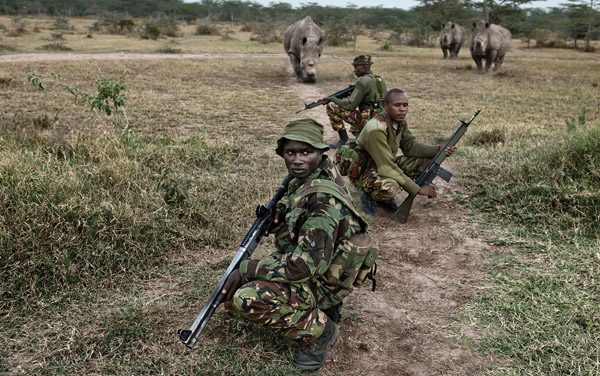Kate Brooks’s sobering documentary explores the real cost of a piece of rhinoceros horn or elephant tusk. Early on, she sets up a hidden camera and records shopkeepers around the world offering to sell her items derived from various endangered species even though they’re prohibited by law. The film asks why countries, including the United States, allow this underground market to continue, and whether the public realizes the ecological cost illicit poaching engenders.
Brooks aims to inform, drawing out the connections between the vendors and those who continue to slaughter already-dwindling numbers of African elephants. She points out that these aren’t individual actors; rather, they are supported by multi-national networks simultaneously engaged in all manner of criminal behavior—poaching is but one activity. As such, every dollar from the ivory trade helps support the arming of rebel cults such as the Lord’s Resistance Army (LRA), which has a history of committing atrocities across Africa. These shadowy organizations also deal in drugs, human slavery, and bribing government officials to avoid prosecution.
There are sanctuaries for elephants in countries such as the Democratic Republic of the Congo. However, those charged with protecting them often find themselves up against the LRA, who sneak in looking to kill the animals for their ivory. Embedding herself with a group of Armed Forces soldiers who serve as park rangers, Brooks follows them on their patrols, which they describe as akin to entering a war zone, given their well-equipped adversary. Indeed, one case of a murdered elephant turns out to have been committed from a helicopter, and the soldiers routinely carry rocket launchers when leaving camp.
Interwoven with the fight to stop the poachers is the fate of the northern white rhinoceros. At the time production began on The Last Animals, there were only seven northern whites remaining, all living in captivity. Brooks derives much dramatic tension from the efforts of conservationists and scientists to keep them from dying out completely, whether that’s by crossbreeding the few surviving females with another type of rhinoceros or taking more drastic measures, such as preserving their genetic material for cloning. The latter offers the possibility of someday resurrecting the species, but the film makes it clear that’s a long shot. What mankind needs to do is alter its behavior in the present.
This is not a particularly upbeat film, but nevertheless it recognizes the heroism of those working on behalf of endangered animals, including Dr. Samuel K. Wasser, a University of Washington professor who has dedicated himself to solving poaching crimes. Brooks follows him as he responds to large-scale ivory seizures around the world, and uses DNA from the recovered tusks to determine the type of elephant and which region of Africa it came from. Wasser figures that most of the illicit poaching is occurring in just two African countries, Congo and Tanzania. Through his eyes, we get an idea of the scale of the carnage: each room full of seized tusks, he says, represents a graveyard for as many as a thousand elephants.
Repeatedly, Brooks returns to the aforementioned Congolese Armed Forces soldiers, paying tribute to their decency. At one point, they carefully remove the body of a poacher killed during a firefight, and the unit leader states they will bury him, because in the end he was a human being. It’s a sharp contrast to the cruel acts carried out by their opponents, who leave the carcasses of the elephants they’ve murdered out in the sun to rot. (These moments are every bit as alarming as the footage in similarly-themed documentaries, such as 2015’s Virunga).
Ultimately, The Last Animals doesn’t offer solutions to the poaching problem so much as an outline of just how serious it is. But by reminding us throughout that human beings can transcend their worst impulses, it offers hope.
It screens at the Tribeca Film Festival on April 23, 26, and 27.

















Leave A Comment